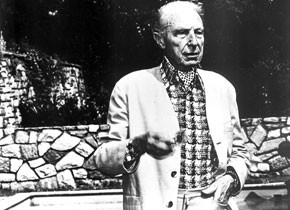Douglas Sirk
April 7 to 30, 2006
"The films of Douglas Sirk liberate the mind.” (Rainer Werner Fassbinder)
Throughout the month of April, the Film Museum will juxtapose the films of Claude Chabrol with a selection of works by a German emigré and Hollywood auteur whose career ended at precisely the same time as the French New Wave directors began their ascent. It was this younger generation of European cinephiles (including Jean-Luc Godard and especially Rainer Werner Fassbinder) who were the first to recognize the rank and the distinctive quality of the films of Douglas Sirk.
Due to four of his late 1950s masterpieces – All That Heaven Allows, Written On the Wind, The Tarnished Angels and Imitation of Life – Sirk came to be celebrated not only as an oustanding stylist, but as a great figure of "subversion” in American entertainment. Upon close examination, his melodramas proved to be deeply ironical and acerbic critiques of the American Dream.
His intentionally artificial mise-en-scène – bigger than life in every sense of the word – and his development of reflexive devices (blindness and mirrors are merely two characteristic key motifs, with which Sirk cleverly "fragmented" his formally perfect veneer) revealed the signature of a sensitive artist who had come to accept the rules of the studio system while figuring out how to transcend them at the same time.
Douglas Sirk (1897-1987) was born Hans Detlef Sierck in Hamburg. He was a successful stage director in Germany, with a pronounced fondness for Shakespeare and the modern theatre of Brecht and Weill. After a few successful movies for the German UFA, he and his Jewish wife emigrated in 1937, with a circuitous route eventually bringing him to the United States He lived there as a farmer, studied American customs and started working as a Hollywood director in 1943.
It wasn't until his engagement at Universal in 1950, however, that Sirk truly came into his own. The spot-on foreigner's view of American popular culture, the influence of Brecht and the decision to favour so-called "women’s pictures" added up to a magical constellation: tearjerkers were transformed into films that carry the power of classical tragedies. All I Desire. There's Always Tomorrow. Magnificent Obsession. The titles speak a clear language, even when the films take place in different times and continents, as in the World War II drama A Time To Love and a Time To Die (1958), possibly the director's most beautiful work.
The Film Museum's selection presents Sirk's famous US melodramas as well as a little-known trilogy of musical comedies: Has Anybody Seen My Gal? (1952, with the young James Dean in a small role), Meet Me At The Fair (1953) and Take Me to Town (1953). Plus: Sirk's personal favourite, the historic crime caper A Scandal in Paris (1946) with George Sanders as both crook and Chief of Police.
Starting in 1953, Sirk's interest increasingly tended towards what was simmering under the surface of American society during the economic upswing of the post-War years: the repression and hypocrisy in families, the longings of women, and men not being able to live up to the prevailing ideals of masculinity.
With these films, the classical Hollywood cinema comes to its logical ending. Written on the Wind in particular, with its undertone of sexual hysteria and its culmination in an explosion of colours, is an indication that changes in the social order also require commensurate changes in the style of entertainment. Just when Sirk had achieved his greatest success with Imitation of Life (a title which almost sums up his late works), he ended his career. His decision was taken due to poor health, but it had also become clear to him that his kind of cinema would not last. It could only be reinvented – elsewhere, in a different style, by another generation of passionate filmmakers.
